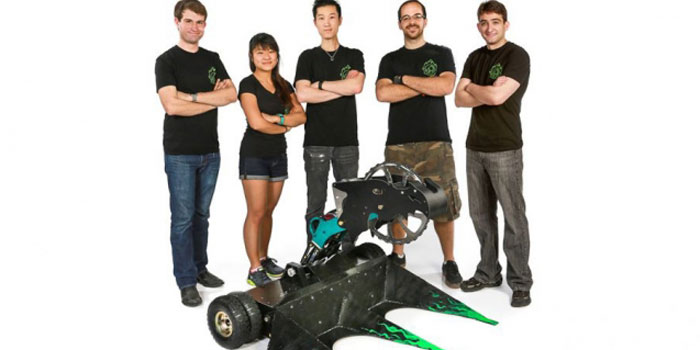MIT Students Field Several Fighting Robots In Season 2 Of BattleBots

The SawBlaze team includes: John Mayo ’16; Lucy Du ’14, SM ’16; Jamison Go ’15; graduate student João Luiz Souza Ramos; and Christopher Merian ’16.
LOS ANGELES — A robot that can throw fire and saws into its opponents with a spinning blade; a 250-pound bot that can damage and throw competitors with a steel drum powered by its 100-horsepower motor; and a robot with two sets of arms to grab and hoist other machines: These are some of the robots developed by MIT-affiliated teams selected to compete in the second season of ABC’s “BattleBots.”
Throughout the 2016 spring semester, four teams of MIT students, research staff, and alumni worked to design, construct, and test combat robots for the “BattleBots” competition, a reboot of the Comedy Central classic that pits homemade combat robots against one another in an elimination-style tournament.
For the MIT participants, competing in “BattleBots” was an opportunity to not only design and build the combat robot of their dreams, but also to apply and test engineering concepts in an exhilarating, hands-on manner. In addition to their academic coursework and extracurricular activities, the competitors dedicated countless hours to building their robots from the ground up, work that provided them with a diverse range of engineering experiences.
“One of the more fun things about ‘BattleBots’ and combat robotics in general is you get to do head-to-head engineering with other people and you get to do it in a pretty low-stress environment. It’s okay if it breaks and blows up because that’s what it’s supposed to do,” says Rebecca Li, a rising senior who led the development of a robot named The Dentist, which features a spinning drum powered by a 100-horsepower motor. “I think that’s what makes it a great hobby sport.”
The high level of participation by MIT affiliates in “BattleBots” is an example of MIT’s thriving maker culture, according to Dawn Wendell ’04, SM ’06, PhD ’11, a senior lecturer in the Department of Mechanical Engineering who participated in “BattleBots” as an MIT student during the original Comedy Central show.
MIT’s ability to field four teams stems in large part from the many makerspaces on campus where students can build, tinker, and experiment on projects outside the scope of their academic activities. “BattleBots” participants used a variety of these makerspaces to construct their robots. Participants say they feel fortunate to have such resources on campus to support their efforts.
“It’s important to have these spaces that are flexible for applications beyond their intended usage,” says Charles Guan ’11. Guan led the Equals Zero Robotics team, which designed their robot, Overhaul, with an upper and lower set of arms so that the robot could grasp and hoist opponents. “Having an unofficial base of operations for a lot of student activities is a source where we get a lot of MIT’s innovation.”
The shared spaces where many “BattleBots” participants built their machines also helped foster a spirit of camaraderie between the teams. Despite the fact that they were building separate robots, the four MIT-affiliated teams frequently collaborated and assisted one another with any roadblocks they ran into during their design and building process.
MIT’s strong presence at this year’s competition is in keeping with the Institute’s long history of participation in “BattleBots.” When “BattleBots” returned to television on ABC last year, a team of MIT affiliates, students, and alumni participated in the competition.
“It’s really fantastic to see that by having “BattleBots” back on TV it has gotten the general public really excited about engineering and robots. And it’s cool to be able to tell my students, who normally see me in a very official role or who see me in the classroom, that I was once in their shoes,” says Wendell. “I was an undergrad and I was building robots and hoping that they would work, but learning a lot in the experiences where they didn’t work as well as I had hoped. And that is a really acceptable and really awesome way to learn.”
Source: MIT News
